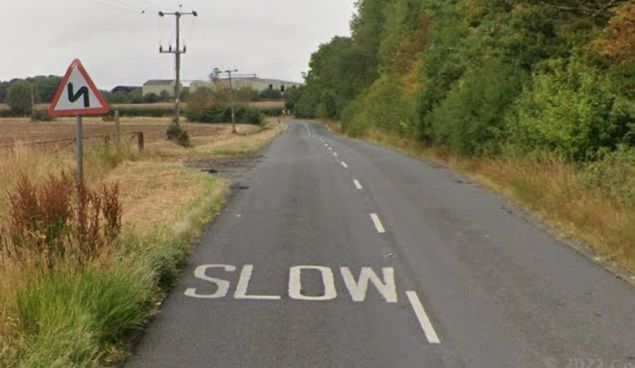Introduction
Once you have been on the dual carriageway and built your speed to 50/60MPH, use 5th and 6th gear and have a good understanding of the Hazard and L.A.D.A routine's when on dual carriageways and more complex roads, this will also include multi lane roundabouts and slip roads. Then you will then be briefed on progressive driving on country roads. This will consist on negotiating different types of bends and tackle various speed limits altering your speed from 30mph to 60mph back to 30mph then 60mph etc..
There is a test route at the Grimsby driving test centre and and it takes you through Laceby village.
Due to this being an independent test route you will have to follow road signs and not use a sat nav.
You will be asked to follow the signs to Healing/Stallingbough and then Aylesby and Laceby, then back to M180/A180 (this is a genuine test routes and you will find the full route in the link below).
Click on the link below and open test route D.
Agreed lesson is covering :-
Using the L.A.D.A and M.S.P.S.G.L routine's when driving around country roads and village areas. This lesson you will be working on your independency when dealing with country roads and bends while reducing your speed safely and reacting in safe manor as and when necessary.
You will continue to develop with last lesson brief:-
- Negotiating crossroad and decide the best technique "Nearside to Near side or Offside to Offside"
- Meeting, overtaking, adequate clearance when overtaking stationary/slow moving vehicles, hold back and maintaining a two second gap
- Hill and angle starts
- Complex junctions, roundabouts/mini roundabouts/traffic lights and pedestrian crossings
- Awareness and planning
- One way/Town/City location
- Dual carriageways a slip roads
- Multi lane roundabouts
Intervention
Agree on what part of the lesson is going to be a instructor-lead-lesson and client-centred-lesson and if it is client-lead agree if the instructor has to intervein verbally, take control of the training vehicle by ether using the dual control or take the wheel the lesson plan may need to be changed until the fault is fixed.
F.I.S.H
Fault
Implication
Solution
Help
Lesson aims and strategies
Todays briefing will be using the L. A. D. A and M.S.P.S.G routine's on A and B roads, building your speed on single national speed limit roads and reducing your speed safely to negotiating left and right hand bends. Throughout the course you will have to plan at times to overtake a slower moving vehicle. The above routine's will be broken down to help you develop your skill to organise your approach and planning with all situations.
You and your instructor will agree lesson plan support to ether:-
- Full talk through
- Prompt
- Independent
This is important to ensure that the instructor and student understands who has the main responsibility on the control of the training vehicle on the set lesson plan.
Your level of instruction will be given by your instructor to a level to suit you from full talk through then reducing your support to either prompt or independent.
What is thedifferences between A roads and B road
- A roads are wider, more direct routes designed for through traffic.
- B roads serve as feeder roads connecting A roads to smaller local roads.
- A roads can have one, two, three or four digits, while B roads can only ever have three or four digits.
Progressive driving v Speeding
Progressive driving is about making maximum progress on your journey without putting anyone else at risk or in danger. Unfortunately slower traffic and long queues get drivers angry and will take unnecessary risks to overtake when they are not 100% sure it was safe too. When you’re driving always think of :-
- The weather conditions
- The road conditions
Speeding can result in a:-
Waste of time, Waste of energy, Waste of fuel and lastly fatalities!!!
Speeding defiantly causes potential and actual accidents and unfortunately deaths. There are driver’s that continually drive beyond their limitations everyday just because they can. Even a sensible driver just running late for an appointment rushing to get there on time can have one error of judgement and cause an accidents.
Boy/Girl racers
You may think once you have passed your driving test its fun to take a corner or bend at 50/60mph... What if you loose control just as your going around a corner and you come head on with another vehicle, cyclist, jogger or even a family walking...
Have I got your attention yet? PLEASE think of the consequences on hurting an innocent bystander as you have lost control as you have turned your motor vehicle into a killing machine.
If your having a little giggle about the above now think of this another way, Now put yourself in the middle of no where driving and you loose control of your vehicle and end up in a ditch or even worse hit a tree head on (a tree will not move like a lamppost). Their is no one around to help you as your in the middle of no where. What if you are not found for 3 to 5 days.... I'm writing this as it has happened.
However you could be the lucky one and it could be someone else that got hurt. Could you really live with yourself if you ruined a life just because you can!! It takes a split second to ruin a life. THINK safety and drive safe.
Speed V Progress
Speeding does not necessarily equal progress! Remember you are in a killing machine and one wrong decision can be fatal. Imagine you were driving in a queue of slow moving traffic that had very few gaps to overtake, there would be little point in racing to overtake at every opportunity. You would probably cut a 60 min journey by 5 or 10 minutes. But think of the carnage you could leave behind you.
Eco driving
Constant accelerating and braking will affect your suspension, fuel consumption and physical body energy from all of the extra concentration you would need to cope with when overtaking and the constant changes of speed.
Weather conditions
In rainy or Icey weather conditions you see less and your stopping distance is longer (rain X2 snow/ice X10), your tyres will have less grip on the roads that you are on. Your observations could be compromised as the rain could have misted your front windscreen or the sun could be in your eyes.
Always consider the season you are in:-
- Spring = Trees start to blossom (open areas become closed)
- Summer = low sun
- Autumn = Leave on the ground (skidding issues) Nights draw in
- Winter = Potential snow/ice and freezing conditions

Three golden rules
1. Never drive beyond your limits
2. Allow more time when you are in bad weather or your vision is compromised
3. Always keep the two seconds safety gap
Lesson brief
Negotiate bends
One of the first things briefed on this lesson will be road position needed on left and right bends/corners, the timing of the speed reduction as you approach each bend and the correct gear. This is vital knowledge to successfully negotiate bends at speed to ensure you keep balance on all four wheels. This will then enable your vehicle to achieve maximum adhesion when the weight of the car is evenly spread over each wheel and across the whole of the tread of the tyres.
Left bends
On a left bend you will see visually less compared to a right bend as you are approaching corners.
Potentially you could be travelling on a straight country road at 50/60mph and approaching a bend, not all corners are as sharp as each other, reading warning triangles and black and white chevron can help with the sharpness of the up and coming corner. The greater the chevron the sharper the corner. However if the area is new to you kill your speed and don't risk your life.

Accompany the Warning triangle sign above you will see road paint saying slow or a sign saying reduce speed now.



Correct positioning
Let’s say we are on a 60MPH road and incorporate the hazard and L.A.D.A routines.
L.A.D.A to scan the road for the triangle sign and the black and white chevrons (or even assess the tree line).
Start to reduce your speed to 40/30 MPH 4/6 lines from the start of the corner (or at the triangle sign):-
Negotiating a left bend:-
Mirrors (centre and left)
Signal (brake lights)
Position (centre of your lane)
4/6 lines from the corner
Speed (decrease to 25/30MPH)
Gear to 3rd gear
L.A.D.A to scan the road ahead and make progress.
Negotiating a right hand bend:-
Mirrors (centre and right)
Signal (brake lights)
Position (left of your lane)
4/6 lines from the corner
Speed (decrease to 25/30MPH)
Gear to 3rd gear
L.A.D.A to scan the road ahead and make progress.

Braking on the bends
When your negotiate bends use your brakes progressively as you approach and slow down to a sensible speed, you should not need to braking or accelerating as you enter the bend.
Accelerate gently as you are coming out of the bend and build your speed up once you can see its safe to do so.
Last minuet braking could make your vehicle skid out of control.

Steering
When negotiating bends always turn your steering wheel gradually and smoothly without jerking (the golden rule is when u drive fast "move the steering wheel slow" and when you’re going slow i.e. when reversing "move the steering wheel fast". Follow the shape of the curb and DO NOT turn the steering wheel sharply as you could easily skid and cut across to the other side of the road or allowing your road position to become a hazard to oncoming vehicles.
Overtaking at speed on single carriageways
Overtaking slower moving vehicles on a single ("A" roads) carriageway is potentially the most dangerous manoeuvre you can perform. You are temporary driving on the wrong side of the road and driving at a higher speed. Traffic may appear from ahead if you time it wrong. Always choose a safe place to overtake, never overtake immediately after a warning sign.
You need to look well ahead (L.A.D.A) for these hazards, road markings and signs.
Dead ground
One physical hazard that is not easy to spot is something called Dead Ground or blind summit.
This is where the road dips and gives you the illusion that there are no oncoming vehicles when in fact there are.
Using your L.A.D.A observations look ahead so you see the vehicle approaching you then you will see it disappear (awareness and planning).
Never over take on a hill, bend, signs saying dead ground or blind summit.

There are two important points to learn from this
- Firstly - if your view ahead is NOT absolutely clear wait and DO NOT overtake a slower moving vehicle that is in front of you..
- Secondly - Always be prepared to brake and abort overtaking if necessary.
Occasionally you will find yourself in a stream of vehicles all of which intend to overtake a slow moving vehicle.
Make sure that you can see clearly ahead before overtaking in this situation. Never ‘blindly’ follow the vehicle ahead assuming that it is safe.
The overtaking procedure
The overtaking procedure is similar to that was covered on the dual carriageway lesson.
However we now have to consider oncoming traffic on a single carriageway, again you would probably use the hazard drill at least 3 times as shown below:
Overtaking a bicycle, moped, mobility scooter or a motor vehicle
Before you contemplate overtaking a slower moving vehicle always consider the road markings and signs but definitely the road markings. Do you know these road markings?
Teaching & Learning Strategies
Like mentioned earlier every student is induvial and each and everyone of you will progress at different rates so driving will adapt their lesson plan to help you achieve your driving goals.
- Your driving instructor will adapt their teaching style to suite your ability and ability
- Your driving instructor will continue to encourage you on your lesson and analyse any problems made and allow you to take responsibility for your own learning goals by giving you technical information to improve your techniques. Your technical feed back from your instructor will be ether given on the move or if feel needed by pulling you up on the side of the road somewhere safe, legal and convenient.
Rote learning (WikipediA)
Rote learning is a memorization technique based on repetition. The method rests on the premise that the recall of repeated material becomes faster the more one repeats it. Some of the alternatives to rote learning include meaningful learning, associative learning, spaced repetition and active learning.
At the end of your lesson
At the end of your lesson you will have a debrief with your instructor giving you the opportunity to reflect on your performance on your lesson then you can set up new goals for your next driving lesson.
This will also give you the opportunity to research any new topics that will be brought into on your next agreed lesson. So remember your instructor is there to HELP you, so on your driving lesson if you have any uncertainties or need anything rewording or recapping to make things any clearer, just ask.


